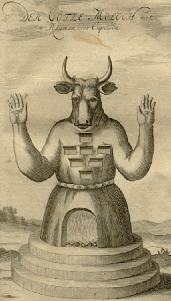At Nashotah House I met my first real-life servant.This was a student—a candidate for the priesthood—who’d formally been a “domestic.”Now, being Episcopalian one doesn’t bat an eyelash at that sort of thing but I was secretly in shock that servants still existed.I’m woefully uninformed about aristocracy.Having grown up poor I resent the idea of a person being placed in the role of fulfilling the whims of someone just because they have money.My wife has more of a fascination about this than I do, and she was recently reading a book about servants.This post isn’t about domestics, however.It’s about foreign gods.In the book she was reading my wife noticed one of the servants writing that old-fashioned stoves were like Moloch.Were it not for Sleepy Hollow, I suspect, many modern people wouldn’t know the name at all. Who was Moloch?
Moloch, according to the Bible, was a “Canaanite” deity.Specifically, he was a god that demanded child sacrifice.The phrase the Good Book uses is that his worshippers made their children “pass through the fire” for Moloch.Very little is known about this deity, and the question of human sacrifice is endlessly debated.Theologically it makes sense, but practically it doesn’t.Deities want servants and living bodies do that better than dead ones.Although it’s been suggested that “passing through” could be a symbolic offering, by far the majority of scholars have taken this act as an actual sacrifice.The ultimate servant is a dead servant.Moloch, you see, comes from the same root as the word “king.”And kings are fond of having many servants.

Image credit: Johann Lund, Wikimedia Commons
So how is a stove like Moloch?The classic image of the god, which looks like a scene from The Wicker Man, holds the answer.Well circulated since the early eighteenth century, this engraving has captured the imagination of modern people.A massive, multi-chambered statue intended to consume by the raging fire in its belly.This is the way in which a stove might resemble a Canaanite deity.The servant who described cookware thus knew whereof she spoke.Archaeological evidence for the “cult of Moloch” is slim.It is almost certain that nothing like this fanciful image ever existed.Moloch, in other words, lives in the imagination.One aspect, however, rings true.Like most tyrannical rulers the deity wants unquestioning obedience on the part of servants.And this is a viewpoint not limited to deities.
